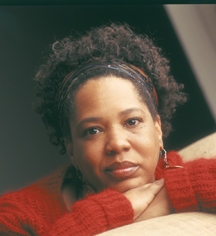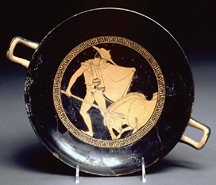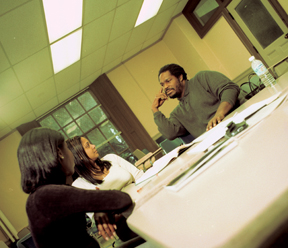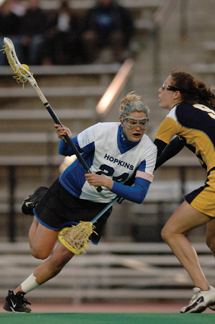






 |
||||
 |
 |
 |
 |
 |
 |
||||
|
PRIDE We looked . . . we just didn't have much luck uncovering the kind of excessive, damaging, mean-spirited pride that appeared as superbia in Pope Gregory's list of deadly sins. Then again, we did find plenty of things to be proud of — but this is Johns Hopkins. (Were we not supposed to say that?)
|
|
| Photo by Mark Lee |
 McDonald, a Johns Hopkins associate professor of
sociology, had heard
similar comments before. One black woman might be dismissed
as "ghetto," another as "too white." "I'd be hanging out
with my middle-class friends, and someone would refer to
black women as 'other,' as someone they couldn't relate to
because of class," she says.
McDonald, a Johns Hopkins associate professor of
sociology, had heard
similar comments before. One black woman might be dismissed
as "ghetto," another as "too white." "I'd be hanging out
with my middle-class friends, and someone would refer to
black women as 'other,' as someone they couldn't relate to
because of class," she says. Where was the sisterhood? wondered McDonald, whose previous work has focused on African-American women and families; intersections of race, class, and gender; and the sociology of the family. Theories about the growing African-American middle class suggested a divide in the African-American community between the haves and the have-nots. How was this affecting black women in particular? And what, if anything, did these sisters have in common? What McDonald found surprised her. Regardless of age, income, educational attainment, or racial identity, the 88 Baltimore-area women she surveyed shared a major trait: pride. No matter what kind of academic degrees they held, where they lived, or how much money they made, the overwhelming majority of women McDonald surveyed — some 94 percent — said they took "great pride" in being black women. "This is not an egotistical pride, it's community pride," McDonald explains. "It's pride in collective survival. Most black folks will say we shouldn't be here. We never should have made it through slavery. All you have to do is see a black woman walking down the street and you can see her pride." Why Oprah? "Everyone talks about Oprah — whether they like her or not," says McDonald. "She is a contemporary test for so many people — can one 'remain black' in spite of one's success? To embrace Oprah is to recognize and accept the broad spectrum of black womanhood and what authenticity can mean for different women — and still recognize that which the vast majority of black women share." —MB |
|
Theseus with a Wounded Boar, attributed to the Antiphon
Painter (Attica), ca. 480 B.C. Photo courtesy The Walters Art Museum |
 However, in Greek history, pride was a good thing,
says H. Alan Shapiro, the W.H. Collins Vickers Professor of
Archaeology at Johns Hopkins. For the ancient Greeks, the
pride they took in their heroes helped to form their
collective identity.
However, in Greek history, pride was a good thing,
says H. Alan Shapiro, the W.H. Collins Vickers Professor of
Archaeology at Johns Hopkins. For the ancient Greeks, the
pride they took in their heroes helped to form their
collective identity. "The civic identity and civic pride of Athenians particularly is shaped by their worship of a number of heroes, including Theseus," says Shapiro, who is writing a book on the topic. The Athenian king was strong, brave, and resourceful. "Theseus was considered the national hero of Athens," Shapiro says. People built shrines to honor him, held festivals in his name, and painted his image on pottery. Shapiro has studied hundreds of those images to understand Theseus' place in Athenian society. The people's pride in Theseus was a great unifier, he explains. Worshiping the king "was a way to help bring everyone together — like we might have in the Orioles or in Cal Ripken today." —MB |
|
Green with urban counseling students Shana Quick (l) and
Shayla Harris. Photo by Christopher Myers |
 "It's community pride, in a sense, but we don't overlook
the negatives. It's empowering, not enabling," says Green,
who directs the Urban School Counseling program within the
Johns Hopkins School of
Professional Studies in Business and Education, which
each year prepares about a dozen master's candidates in
this field.
"It's community pride, in a sense, but we don't overlook
the negatives. It's empowering, not enabling," says Green,
who directs the Urban School Counseling program within the
Johns Hopkins School of
Professional Studies in Business and Education, which
each year prepares about a dozen master's candidates in
this field.Green offers the example of a Baltimore City high school student who had been flagged by his principal for excessive aggressiveness and absenteeism. The boy's father had recently been arrested for killing his girlfriend and was in jail, and his mother was out of the picture, either dead or in prison. The boy's aunt had grudgingly allowed him to live with her, but offered no food or financial support. A recent graduate of the urban school counseling program began working closely with the young man. He offered traditional bereavement support, and also covered the history of drug use and violence in the city, exposing the teen to books, newspaper articles, and other sources of information. The young man grew to understand how his father had gotten caught up in drugs, and why his neighborhood was so dangerous. "The kid really grabbed hold of this," Green recalls. "Rather than sinking further into depression, [he was] motivated to get a part-time job — to take some responsibility and not feel sorry for himself." Green recalls another instance, when he was working with some teenage boys at an East Baltimore school. The group was talking about rap music and the factors that influenced it when the conversation turned to reading. Green made the point that it was once illegal for slaves to read and that Frederick Douglass risked his life to learn how. The informal history lesson made a particular impact on one teen, Green says. "This really fired this kid up. It motivated him. It made a difference in how he approached school." Many aspiring counselors who come to the program are former classroom teachers who find themselves stymied by the serious social and emotional issues their students face. "They spend most of their time dealing with crises — they see their task as being teachers seriously impeded," Green says. Veronique Gugliucciello, who completed her master's in Urban School Counseling in May 2004, had taught at Gardenville Elementary in Baltimore for several years before moving to counseling. "I felt I needed to touch my students on a different level," she says, adding that she's found value in the urban counseling approach. "It's empowering for students to know about the environment they are living in and why things are the way they are." —SD
A Washington Post article from January 2004 put it
this way: "Long one of the most revered names in academic
medicine — and for more than a dozen years ranked the
nation's best hospital by U.S. News & World Report
— Hopkins has embarked on a new and potentially
lucrative venture so at variance with its international
reputation for gravitas that it would have been unthinkable
a decade ago."
But Craig Vander Kolk, a professor of
plastic
surgery at the School of Medicine who was instrumental
in founding the center, is proud of the work he does there
— because it enables him to help instill a little
pride in others: "We're interested in helping people feel
good about themselves," he says.
Vander Kolk, now one of the center's directors, has
specialized in treating kids with cleft lips and cleft
palates, and is recognized internationally for his research
in craniofacial surgery. He brings his experience and
skills from that work to cosmetic surgery. "I approach
cosmetic patients the same way as cleft palate or cleft lip
kids — I approach them as a person," Vander Kolk
says. "I help get them feeling like their outside is the
same as their inside."
The center is staffed by Hopkins docs whose specialties
range from otolaryngology and oculoplasty to vascular
surgery and interventional radiology. Combined, they have
about 2,000 patient visits a year; Vander Kolk alone
performs more than 300 procedures per year on patients
ranging in age from 35 to 75. Younger women most often have
less invasive procedures like eyelid surgery (called
blepharoplasty) and Botox or Restylane injections (both
treat wrinkles and folds; the former does so by weakening
the muscles, the latter fills the areas in), while older
women may also have some type of facelift. The most common
procedures for men include blepharoplasty, botox, and neck
lifts.
Prices for these procedures — which depend on a
patient's age; his or her individual anatomy, needs, and
goals; and the surgeon who does the work — can run
from a few hundred dollars (for Botox or Restylane) to
several thousand (for blepharoplasty or a facelift).
According to Vander Kolk, eyelid surgery can cost anywhere
from $3,000 to $7,500, and a facelift — including the
neck, cheeks, and jawline — can cost up to
$12,000.
With shows like Extreme Makeover and The Swan
out there, cosmetic surgery is a fact of life. (Maybe too
much of one. At cocktail parties, says Vander Kolk,
"everybody thinks that, as a plastic surgeon, I'm on
Nip/Tuck.") His goal is to make Green Spring Station
a center of excellence for cosmetic surgery, focusing on
education, outcomes research, and patient safety. And he
thinks that Hopkins is the right institution for the job.
"It's out there. It's medicine. We should be leading the
way," he says. —CP
|
| Photo by Jay Van Rensselaer |
 The fans didn't come right back, of course, but Tucker says
it's pride, not cheering multitudes, that motivates her
players. "It's ideal to play in front of a crazed crowd,
but it's not something driving these women," she says.
"They play for the love of the sport and their commitment
to the school. It's pride in playing for Johns Hopkins. The
girls are very sensitive to putting on that uniform and
knowing what it stands for, whether there's one person
watching or 100,001.
The fans didn't come right back, of course, but Tucker says
it's pride, not cheering multitudes, that motivates her
players. "It's ideal to play in front of a crazed crowd,
but it's not something driving these women," she says.
"They play for the love of the sport and their commitment
to the school. It's pride in playing for Johns Hopkins. The
girls are very sensitive to putting on that uniform and
knowing what it stands for, whether there's one person
watching or 100,001."You know, it was interesting: The group of fans, other than parents, that ended up staying [for the Princeton game] was our men's team. As all the thousands left after watching our boys play, it was very cool for our girls to look up in the stands and see that our men's team had delayed [going] home and stayed. It meant a lot and was very touching." —DK
|
 |
|
 The Johns Hopkins Magazine |
901 S. Bond St. | Suite 540 |
Baltimore, MD 21231
The Johns Hopkins Magazine |
901 S. Bond St. | Suite 540 |
Baltimore, MD 21231Phone 443-287-9900 | Fax 443-287-9898 | E-mail jhmagazine@jhu.edu |
|